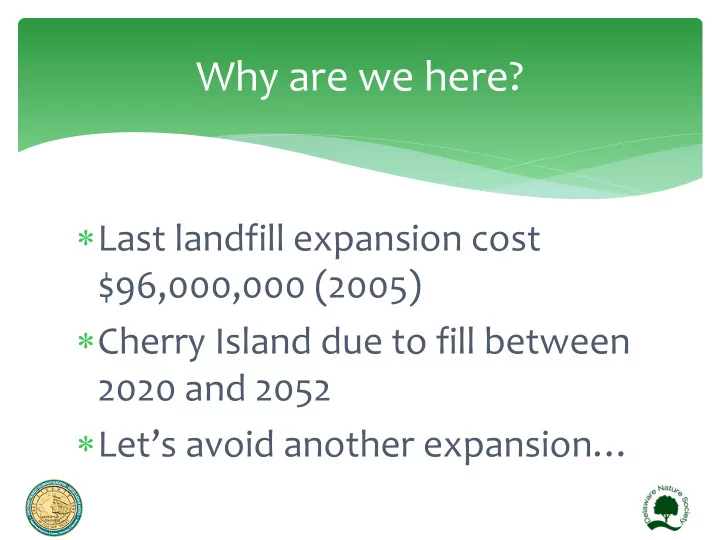

Why are we here? ∗ Last landfill expansion cost $96,000,000 (2005) ∗ Cherry Island due to fill between 2020 and 2052 ∗ Let’s avoid another expansion…
“If we do not change our direction, we are likely to end up where we are headed.” - Ancient Chinese Proverb
Facts ∗ About 50% of landfill content is Organic ∗ Organics = Energy ∗ Energy = ∗ Recycling = 10x the jobs of landfilling
All the Pieces Legislation / Strategy Waste Organic Recycling Product Producers Process / Technology (Who/What) Education Stakeholders Rules / Enforcement / Measurement
Legislative Strategy ∗ New England – Connecticut, Vermont, Massachusetts ∗ Clear measurements ∗ Tiered system ∗ Accountability ∗ New York City ∗ California
Organic Recycling Process/Technology ∗ Depend on type of organic waste ∗ Large cardboard or paper waste producer ∗ Enforce existing channels for recycling ∗ Ban of these items in landfill ∗ Food waste – high energy potential ∗ Education and awareness of possibilities ∗ Each waste producer can pick what works best for them…
Organic Recycling Process/Technology ∗ Large Central Facility ∗ Needs – about $100 million; waste travels; 100,000 tons of feedstock ∗ Benefits– high diversion from landfill, more jobs, $13 - $30 million revenue, attracts investors ∗ Several Smaller Facilities – one per county ∗ Needs – smaller initial investments/ larger total investment, state support, less profit ∗ Benefits - waste travels less, local access, same revenue
Organic Recycling Process/Technology ∗ Business Facilities ∗ Larger businesses creating own energy ∗ Perdue, Casinos, DuPont ∗ Benefits – energy source, lowered expenses, free feedstock, haulers less travel, quick payback ∗ Needs – continuous flow of feedstock, $6 to $8 million ∗ Research Facilities ∗ Through educational institutions used as teaching, research and production facilities
Product & Investment ∗ Capital investment varies ∗ Smaller facilities: $6-8 million; $40 to $60 million ∗ Larger facilities: $100 million + ∗ Profit threshold – 100,000 tons where companies will come in and build facility ∗ Grants ∗ Federal Renewable Energy Grants ∗ Research Grants ∗ Compliance to Law Grants
Anaerobic Digestion Technology ∗ Digestion of organic material with microorganisms ∗ NO OXYGEN = NO AIR FLOW = NO SMELL ∗ Generating methane (biogas) ∗ Methane converted to electricity / biofuel / heat ∗ Waste product is digestate (fertilizer or fill) ∗ 10 time the number of facilities now then in 2000 ∗ Advances in research
Anaerobic Digestion At-a-glance
Reno, Nevada Surrey, British Columbia Best Practices Edmonton, Alberta Monterey, California Pontotoc, Mississippi San Jose, California London, Ontario Orlando, Florida Vermont Technical University Montpellier, France Fawdon, UK
Goals ∗ Energy from organic waste ∗ Infrastructure for Organic Energy ∗ Zero Waste Strategy ∗ Waste used as a resource and not a liability
Next Steps ∗ Phase in ∗ Food waste, paper, cardboard ban ∗ 2 to 1 ton/week ∗ Etc.
Recommend
More recommend